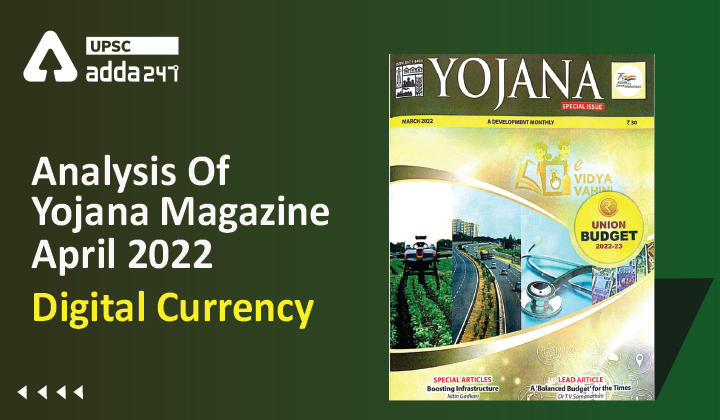Table of Contents
Analysis Of Yojana Magazine ”Digital Currency”
Relevance
”GS 3: IT & Computers, Mobilization of Resources, Banking Sector & NBFCs, Statutory Bodies”
Introduction
- The Reserve Bank of India (RBI) will introduce digital currency in this financial year.
- The use of physical cash in transactions has been on the decline in recent years, a trend further reinforced by the ongoing Covid19 pandemic.
- While interest in CBDCs is near-universal now, very few countries have reached even the pilot stage of launching their CBDCs.
- A 2021 BIS survey of central banks found that 86% were actively researching the potential for CBDCs, 60% were experimenting with the technology and 14% were deploying pilot projects.
What is CBDC?
- Central Bank Digital Currency(CBDC) is the legal tender issued by a central bank in a digital form.
- CBDC is the same as fiat currency issued by a central bank but takes a different form than paper (or polymer).
- It is sovereign currency in an electronic form and it would appear as liability (currency in circulation) on a central bank’s balance sheet.
- The underlying technology, form and use of a CBDC can be moulded for specific requirements.
CBDCs should be exchangeable at par with cash.
What is the Reserve Bank of India – Digital Payments Index (RBI-DPI)?
- The Reserve Bank had announced a composite Reserve Bank of India – Digital Payments Index (RBI-DPI) with March 2018 as base to capture the extent of digitisation of payments across the country.
- The RBI-DPI Index continues to demonstrate significant growth in adoption and deepening of digital payments across the country.
From where did the idea of “Central Bank Digital Currencies” (CBDC) come from?
- The idea of “Central Bank Digital Currencies” (CBDC) is not a recent development.
- Some attribute the origins of CBDCs to Nobel laureate James Tobin, an American economist, who in 1980s suggested that Federal Reserve Banks in the United States could make available to the public a widely accessible ‘medium with the convenience of deposits and the safety of currency.’
- It is only in the last decade, however, that the concept of digital currency has been widely discussed by central banks, economists & governments.
- Except as currency notes, all other use of paper in the modern financial system, be it as bonds, securities, transactions, communications, correspondences or messaging – has now been replaced by their corresponding digital and electronic versions.
What a CBDC is not?
- CBDC is a digital or virtual currency but it is not comparable to the private virtual currencies that have mushroomed over the last decade.
- Private virtual currencies sit at substantial odds to the historical concept of money.
- They are not commodities or claims on commodities as they have no intrinsic value; some claims that they are akin to gold clearly seem opportunistic.
- They do not represent any person’s debt or liabilities.
- They are not money (certainly not Currency) as the word has come to be understood historically.
What is the need for a CBDC?
- Central banks, faced with dwindling usage of paper currency, seek to popularize a more acceptable electronic form of currency (like Sweden).
- Jurisdictions with significant physical cash usage seeking to make issuance more efficient (like Denmark, Germany, Japan or even the US).
- Central banks seek to meet the public’s need for digital currencies, manifested in the increasing use of private virtual currencies, and thereby avoid the more damaging consequences of such private currencies.
CBDCs Advantages over other traditional methods
- Payments using CBDCs are final and thus reduce settlement risk in the financial system. Imagine a UPI system where CBDC is transacted instead of bank balances, as if cash is handed over – the need for interbank settlement disappears.
- CBDCs would also potentially enable a more real-time and cost-effective globalization of payment systems. It is conceivable for an Indian importer to pay its American exporter on a real time basis in digital Dollars, without the need of an intermediary.
- This transaction would be final, as if cash dollars are handed over, and would not even require that the US Federal Reserve system is open for settlement.
- Time zone difference would no longer matter in currency settlements – there would be no ‘Herstatt’ risk.
Conclusion
The introduction of CBDC has the potential to provide significant benefits, such as reduced dependency on cash, higher seigniorage due to lower transaction costs, and reduced settlement risk. The introduction of CBDC would possibly lead to a more robust, efficient, trusted, regulated and legal tender-based payments option. There are associated risks, no doubt, but they need to be carefully evaluated against the potential benefits.



 TSPSC Group 1 Question Paper 2024, Downl...
TSPSC Group 1 Question Paper 2024, Downl...
 TSPSC Group 1 Answer key 2024 Out, Downl...
TSPSC Group 1 Answer key 2024 Out, Downl...
 UPSC Prelims 2024 Question Paper, Downlo...
UPSC Prelims 2024 Question Paper, Downlo...
